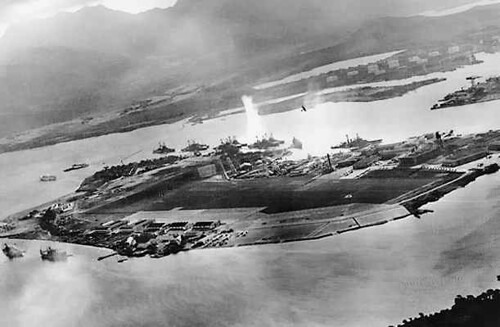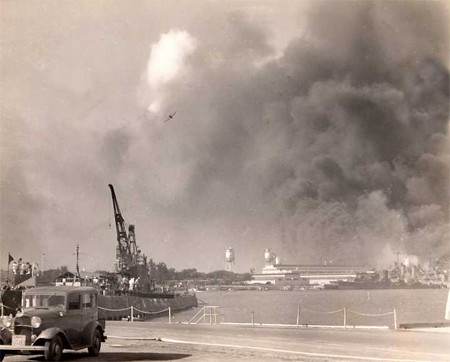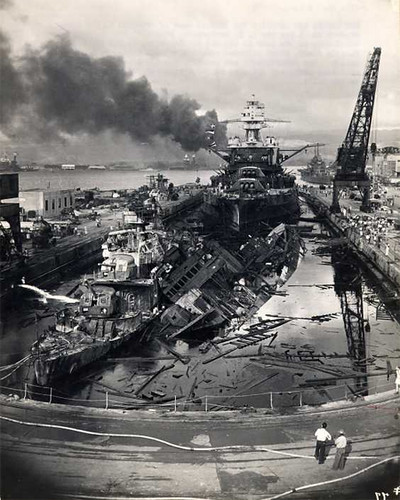 In October 1938, the President of the United States of America, Franklin Roosevelt, asked Congress for $500m to increase the United States of America's defence forces. This action was done because he believed that Germany was a threat to America. Especially considering the continued German military rearmament program and the events at the Munich conference. The Japanese however, saw this build up as a direct threat to their Empire because, America was the only country in the Pacific which could impede their expansion.
In October 1938, the President of the United States of America, Franklin Roosevelt, asked Congress for $500m to increase the United States of America's defence forces. This action was done because he believed that Germany was a threat to America. Especially considering the continued German military rearmament program and the events at the Munich conference. The Japanese however, saw this build up as a direct threat to their Empire because, America was the only country in the Pacific which could impede their expansion.Japan had prepared war plans to deal with any military intervention by America. The Japanese plan was to conduct one large naval battle against the American Navy, destroying it and resulting in the inability of America to interfere with Japanese expansion throughout Asia. Admiral Isoroku Yamamoto assumed command of the Japan's Combined Fleet in August of 1939. Having lived in America for several years he understood the type of people the Americans were and was able to formulate a attack plan that would catch America off guard.
 In July 1939 a trade embargo was imposed on Japan by Roosevelt in an attempt to stop the Japanese expansion. This resulted in an increased ill-will and additional political problems between the two countries.
In July 1939 a trade embargo was imposed on Japan by Roosevelt in an attempt to stop the Japanese expansion. This resulted in an increased ill-will and additional political problems between the two countries.On January 27, 1941 Joseph C. Grew, the U.S. Ambassador to Japan, wired Washington that he had learned information that in the event of trouble with America, Japan, was planning a surprise attack on Pearl Harbor. No one in Washington believed the information and did not believe that the Japanese could surprise them. Most senior American military experts believed that the Japanese would attack Manila in the Philippine Islands. Another thought to location of attack was toward the north into Russia because of the war in Europe between Germany and the Soviet Union.
 American scientists had developed a machine, code named Magic which gave U.S. intelligence officers the ability to read Japanese secret message and consular traffic, which provided all types of high quality information. However, because of preconceived ideas in Washington and internal politics between the Office of Naval Intelligence, the War Plans Division and the Army's own Intel office some data was not followed up or simply disregarded. As a result important pieces of the pre-attack puzzle were missed.
American scientists had developed a machine, code named Magic which gave U.S. intelligence officers the ability to read Japanese secret message and consular traffic, which provided all types of high quality information. However, because of preconceived ideas in Washington and internal politics between the Office of Naval Intelligence, the War Plans Division and the Army's own Intel office some data was not followed up or simply disregarded. As a result important pieces of the pre-attack puzzle were missed. In November 1941, in an attempt to seek a diplomatic solution, Tokyo sent diplomat Saburo Kurusu as a special envoy to Washington to assist Ambassador Admiral Kichisaburo Nomura. Japan wanted the U.S. to agree to its southern expansion diplomatically but if they were unsuccessful, they would go to war.
In November 1941, in an attempt to seek a diplomatic solution, Tokyo sent diplomat Saburo Kurusu as a special envoy to Washington to assist Ambassador Admiral Kichisaburo Nomura. Japan wanted the U.S. to agree to its southern expansion diplomatically but if they were unsuccessful, they would go to war.On Saturday, December 6 1941, the U.S. President Franklin Roosevelt made a final appeal to the Emperor of Japan for peace. There was no reply. Late the same day, the U.S. code-breaking service began intercepting a 14-part Japanese message and deciphered the first 13 parts, passing them on to the President and Secretary of State. The Americans believed a Japanese attack is imminent, most likely somewhere in Southeast Asia.
 On Sunday December 7 the last part of the Japanese message, stating that diplomatic relations with the U.S. are to be broken off, reached Washington in the morning and was decoded at approximately 9 a.m. About an hour later, another Japanese message is intercepted. It instructed the Japanese embassy to deliver the main message to the Americans at 1 p.m. The Americans realized that 1 p.m. Washington time corresponds with early morning time in Pearl Harbour. The U.S. The War Department then sent out an alert but used a commercial telegraph because radio contact with Hawaii was temporarily broken. Delays prevented the alert from arriving at headquarters in Oahu until 12 p.m. (Hawaii time) four hours after the attack had already begun.
On Sunday December 7 the last part of the Japanese message, stating that diplomatic relations with the U.S. are to be broken off, reached Washington in the morning and was decoded at approximately 9 a.m. About an hour later, another Japanese message is intercepted. It instructed the Japanese embassy to deliver the main message to the Americans at 1 p.m. The Americans realized that 1 p.m. Washington time corresponds with early morning time in Pearl Harbour. The U.S. The War Department then sent out an alert but used a commercial telegraph because radio contact with Hawaii was temporarily broken. Delays prevented the alert from arriving at headquarters in Oahu until 12 p.m. (Hawaii time) four hours after the attack had already begun. Pearl Harbour was not on a state of high alert as senior commanders had concluded, there was no reason to believe an attack was imminent and since it was Sunday morning, many officers and crewmen were not on duty. Aircraft therefore were left parked wingtip to wingtip on airfields, anti-aircraft guns were unmanned with many ammunition boxes kept locked in accordance with peacetime regulations.
Pearl Harbour was not on a state of high alert as senior commanders had concluded, there was no reason to believe an attack was imminent and since it was Sunday morning, many officers and crewmen were not on duty. Aircraft therefore were left parked wingtip to wingtip on airfields, anti-aircraft guns were unmanned with many ammunition boxes kept locked in accordance with peacetime regulations.The attack began at 7:53 a.m with the Americans being taken completely by surprise. The first attack wave targeted airfields and battleships. The second wave targeted other ships and shipyard facilities. The air raid lasted until 9:45 a.m. Eight battleships are damaged, with five sunk. Three light cruisers, three destroyers and three smaller vessels were lost along with 188 aircraft. The Japanese only lost 27 planes and five midget submarines which attempted to penetrate the inner harbor and launch torpedoes.
Exercises:
On a new page in your books put the Heading “Pearl Harbour”. Under the heading write a 1/2 page summary based upon the information above. After you have completed the summary, write the following sub-heading and the questions in your books and answer them in full sentences using the link to the website listed below.
Note: you will need to click on "Attack Map".
The Events
1. What did the U.S. Minesweeper Condor encounter?
2. What was U.S. Marine Bert Davis' reaction?
3. What happened to the U.S. destroyer Ward?
4. What was U.S. Sailor Will Lehner's reaction?
5. What happened to the radar operators and their report?
6. Explain what happened to each of the moored boats at 7:55 a.m.




 7:20 AM
7:20 AM
 Mark
Mark



0 comments:
Post a Comment